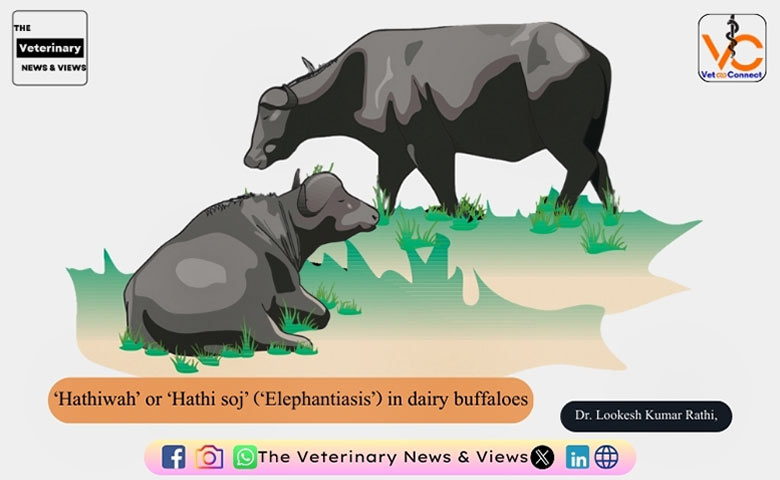Prof (R). Dr. Ghulam Muhamamd and Dr. Lookesh Kumar Rathi, Department of Clinical Medicine and Surgery, University of Agriculture, Faisalabad, Pakistan
‘Hathiwah’ or ‘hathi soj’ is a vernacular term used by the dairy farmers to describe a disease of buffaloes of unknown cause and characterized clinically by fever, swelling of all 4 legs and brisket region. Owing to swelling, the legs of the affected buffalo resemble those of an elephant hence the term elephantiasis. It is a disease of buffaloes only and is sporadic in occurrence. Dilshad et al. (2008) have mentioned this disease under the term Hathi Soj but gave no description of the condition.

It needs to be differentiated from oedematous skin disease of buffalo described from Egypt (Selim, 2001). The most characteristic clinical sign is swelling of all 4 legs. The hind legs are more severely affected than the front legs. There is usually also swelling on the face and brisket region. There is a moderate to high fever, depression, reduced feed intake, reduced milk yield and a slight arching of back. The animal does not like to walk and usually keep standing. Respiration and pulse rates are usually increased.
The disease usually lasts for 1-3 months and case-fatality rate is very high. Blood examination reveals anemia (decreased Hb, PCV and RBC count), microcytic normochromic anemia, reduced number of neutrophils and increased lymphocytes and ESR. Giemsa’s stained smears often reveal clumped RBCs with dotted structures present in them (Unpublished observation of Prof (R). Dr. Ghulam Muhammad, Department of Clinical Medicine and Surgery, University of Agriculture, Faisalabad).
Rajkumar and Murthy (2015) have described a condition in a Murrah buffalo in which signs were almost similar to those given above. Microscopic examination of wet blood film revealed microfilariae.
This buffalo responded very well to administration of ivermectin @200µg/kg SC but signs and microfilaremia reappeared after two months. The buffalo at the repeat attack was treated twice with ivermectin at 1 week interval. These authors ascribed reappearance of microfilaremia and clinical signs to activity of ivermectin against microfilariae only with no lethal effect against the adult parasite.
Rx:
a) Adminsiter a microfilaricide e,g, Inj. Ivomec ® 1%, MSD Pharma Pakistan @ 1 ml/ 50 kg
b) wt. SC thrice at 1 week interval.
c) Give diuretics e.g. Inj. Duretic ® Mylab Pakistan (contains 50 mg furosemide per ml.
Recommended dose rate for cattle/buffalo is 2 ml/100kg b.wt. slow IV. Repeat after 24 hours for 2 days).
OR
Dose the animal with Exitone powder ® , A & K Pharma, Faisalabad; contains hexamine, sodium acid phosphate, ascorbic acid and trihydroxyethyl RUTIN. Dose rate for cattle/ buffalo is 10-15 grams orally for 3-5 days.
c) Inject a long-acting antibiotic (e.g. Inj. Oxtra-LA ® , Fatro Pharma, Italy marketed in Pakistan by Prix Pharma; each ml contains 200 mg of oxytetracycline HCl) @ 20 mg/kg
b.wt. deep IM. Repeat after 2 days.
d) Inject an antioxidant preparation e.g. Inj. Selevit ® Fatro Pharma Italy, marketed in Pakistan by Prix Pharma (contains Selenium and Vitamin E, Adenosinphosphoric acid and Vitamin B1 and B12. Dose rate for cattle/ buffalo is 30 ml IM daily for 5 days ).
e) Administer an antiprotozoan e.g. Inj. Imizol ® MSD Pharma, marketed in Pakistan by ICI Animal Health Division (contains imidocarb dipropionate 120 mg/ml. Dose rate for cattle/ buffalo is 2.5 ml/100kg b.wt. SC, 15 minutes after IM injection of 15 ml of atropine sulphate. Generally, 8-10 ml Imizol ® is sufficient for a cattle or buffalo. This dose may be given in two divided injections at 12 hour interval).
f) Inject parenteral vitamin- minerals- aminoacids e.g. Inj. Aminoplex forte ® agrovet market animal health, Peru. Dose rate is 1ml/5 kg b.wt. IV for 4 days.
g) Administer a detoxicant e.g. Aloe vera fresh leaves 250 grams, cloves (Eugenia caryophyllata; Long in Urdu) 10 grams, Centratherum anthelminticum (Kali jeeri in Urdu) 60 grams and Citrus pseudolimon (Galgal in Urdu) 250 grams. Administer orally one such dose daily for 4 days.
Note: Very good results were achieved when ivermectin was injected subcutaneously at weekly interval for 3 injections along with Inj. Selevit ® injected IM for 5 days (Personal communication of Dr. Muhammad Ashraf, Ex-Manager, Agri Services, Engro Foods, Pakistan).
Modified from:
Dilshad, S. M. R., N. U. Rehman, Z. Iqbal, G. Muhammad, A. Iqbal, and N. Ahmed, 2008. An inventory of the ethnoveterinary practices for reproductive disorders in cattle and buffaloes, Sargodha district of Pakistan. J. Ethnopharmacol., 117: 393-402. Selim, S. A., 2001. Review oedematous skin disease of buffalo in Egypt. J. Vet. Med. B., 48: 241-258. Rajkumar, L., and G.S.S. Murthy, 2015. Microfilariae recurrence in graded Murrah buffalo treated with repeated doses of ivermectin. J. Parasit. Dis. 39(2):262-263.